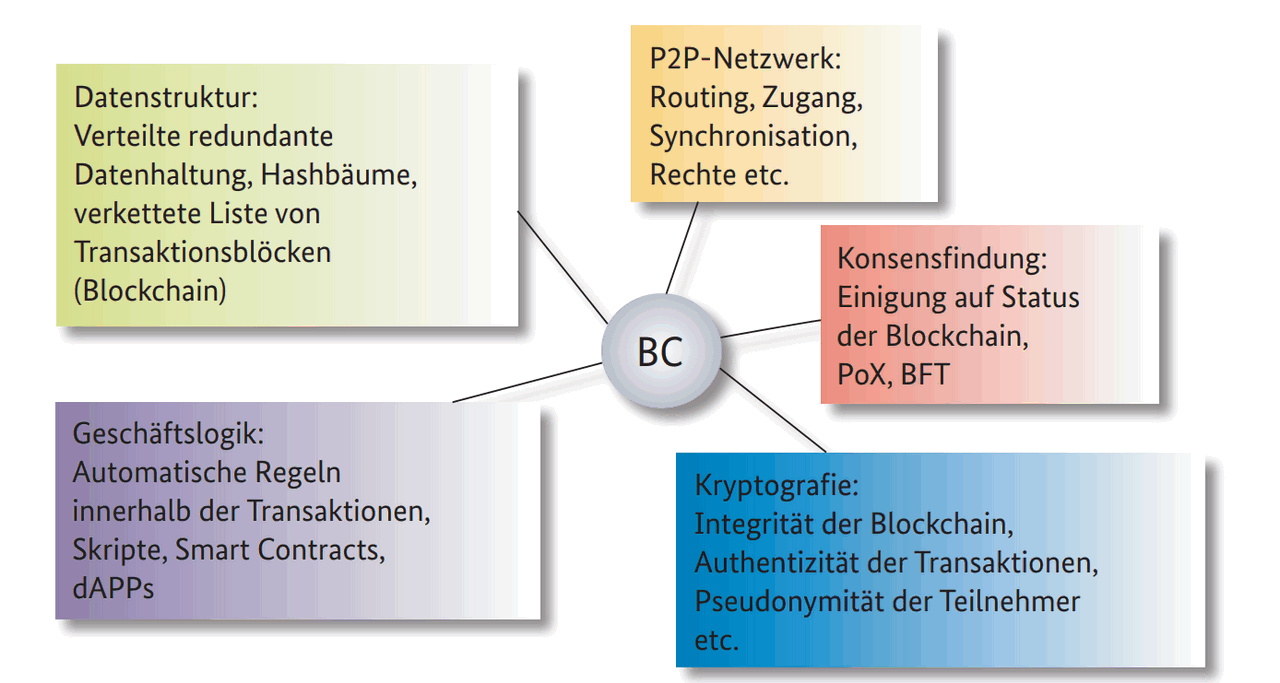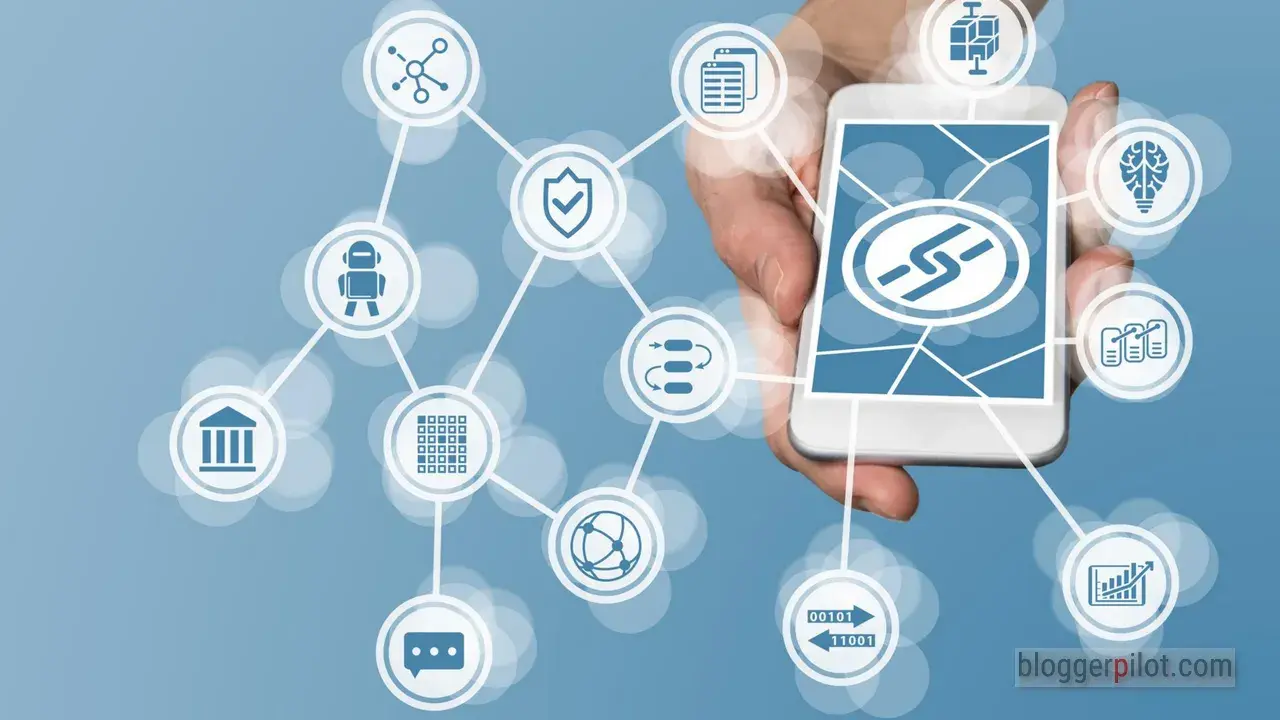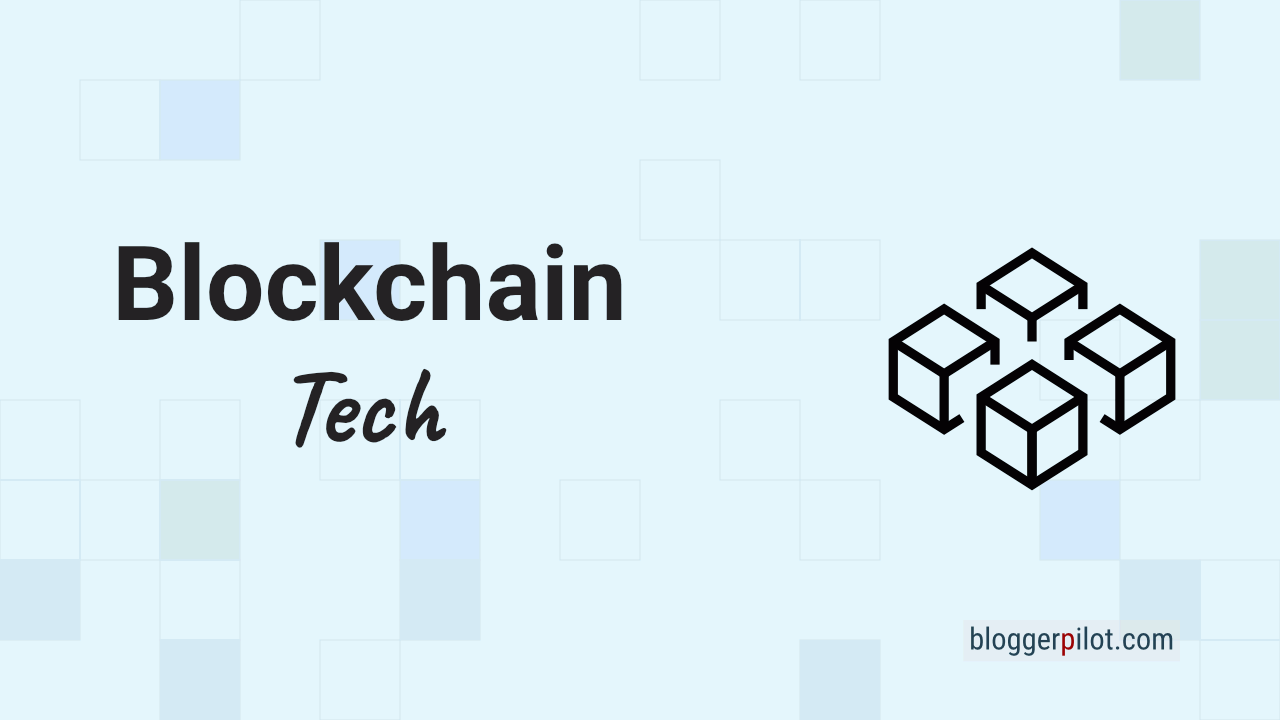Blockchain Technology 2025 and its Application Fields Beyond Cryptocurrencies
Since its first application as a backbone for Bitcoin, blockchain technology has evolved into a revolutionary technology that extends far beyond the realm of cryptocurrencies. Many still understand blockchain as a technology that is only applied in the context of digital currencies.
Blockchain has long since ceased to be relevant only in the context of cryptocurrencies. Rather, the diverse application areas of this disruptive technology are highlighted. From supply chain management to digital identity to healthcare, the scope and potential of blockchain technology is presented.
This article aims to clear up this misconception and highlight the diverse application areas of blockchain technology that could bring disruptive change to various sectors.
Introduction to blockchain technology

What is Blockchain?
Blockchain is a distributed digital ledger stored in multiple nodes or computers. This technology uses cryptography to secure and verify transactions and allows for decentralized management without a central authority.
Why is blockchain important?
The importance of blockchain lies in its ability to increase transparency, security, and efficiency in various business processes. Blockchain technology allows users to conduct transactions and data exchanges without an intermediary, minimizing the risk of fraud and manipulation.
Historical development of blockchain technology
The first concepts of blockchain were developed in the late 1980s, but they did not gain widespread recognition until the introduction of Bitcoin in 2009. Since then, the technology has continued to evolve to serve a wide range of applications in various industries.
Main application areas of blockchain
Although most people associate blockchain with cryptocurrencies, the technology has a much wider range of applications. These include the financial sector, supply chain management, healthcare, real estate, and even public administration.
Aim of the article and reader guide
This article serves as a comprehensive guide to blockchain technology, covering all the important aspects – from the basics and benefits to the challenges and future developments. To facilitate understanding, the article is divided into different chapters, each covering a specific aspect of blockchain technology.
This concludes the overview of the multifaceted and groundbreaking world of blockchain technology. Subsequent chapters will dive deeper into the individual elements of this revolutionary technology.
The basics of blockchain: more than just cryptocurrency

Blockchain technology is a special form of distributed ledger technology that operates in a peer-to-peer (P2P) network. Here, network nodes collectively decide on data updates through consensus. This data can be cryptocurrency account balances, proofs of origin, or contract states in smart contracts. There is no centralized control; each node maintains a local copy of data and can add new. A consensus mechanism ensures that data is up-to-date and consistent.
Cryptographic techniques ensure network access and data integrity. Data processing rules are encoded directly in the records and enforced automatically by the network. In the blockchain, all transactions are grouped into blocks and linked chronologically by cryptographic procedures, forming a tamper-proof data chain.
For many, blockchain technology is inextricably linked to the concept of cryptocurrencies. But this revolutionary approach to data processing and storage offers far more possibilities than just the basis for digital currencies such as Bitcoin or Ethereum. The basic idea of the blockchain is to create an immutable, decentralized register in which transactions or data blocks are recorded chronologically and transparently. This system eliminates many of the weaknesses of traditional, centralized databases, such as the risk of data tampering or loss.
The strengths of blockchain lie in its decentralization, transparency and immutability. Instead of being stored on a single server, the blockchain is hosted on multiple computers simultaneously, making it more robust against failures and tampering. Every change in the data block is communicated network-wide and must be verified by the participants. Once confirmed, the information is virtually immutable, as subsequent tampering would have to change all previous blocks, which is computationally nearly impossible.
This model not only provides security to financial transactions, but also has transformative applications in other fields, such as healthcare, supply chain management, and even the art world. The universal principles of blockchain could ultimately help revolutionize systems and processes across a wide range of application areas.
Structural components

Blocks
A block is the elementary data structure in the blockchain and contains transaction data, a timestamp, and the hash of the previous block. This construction creates an immutable chain of records.
Chain
The chain, or blockchain, is a continuous series of blocks that are cryptographically linked together. It represents a public, distributed ledger of all transactions ever executed.
Node
Nodes are computers connected to the blockchain network infrastructure that help validate transactions and add new blocks. There are different types of nodes, including full nodes, which store the entire blockchain, and light nodes, which store only parts of it.
Consensus Mechanisms
Proof of Work
This is the first and most well-known consensus mechanism popularized by the Bitcoin protocol. It requires miners to solve complex computational problems to validate transactions and add new blocks.
Proof of Stake
This is a more energy-efficient alternative to Proof of Work and allows transactions and new blocks to be validated by holding and “staking” coins.
Public and Private Blockchain
Public blockchains are accessible to anyone and anyone can transact or run a node. Private blockchains, on the other hand, are only accessible to certain members and are often used in enterprise applications.
Smart Contracts
Smart contracts are self-executing contracts whose terms are written directly in code. They are automatically executed by the blockchain and cannot be modified once activated. More on this in a moment.
Tokens vs. Coins
Coins are cryptocurrencies native to a particular blockchain (e.g., Bitcoin, Ether). Tokens, on the other hand, are digital assets created on an existing blockchain that can represent specific functions or rights within an ecosystem.
These basic components and mechanisms form the foundation for a profound understanding of blockchain technology and its many applications.
Benefits of blockchain technology

Transparency
Transparency is one of the fundamental features that have revolutionized blockchain technology. Due to its decentralized architecture, all transactions are visible to every participant in the network. This not only increases trustworthiness, but also the integrity of the entire system landscape.
Decentralization
Unlike traditional centralized systems, no single entity is responsible for recording transactions in a blockchain network. Instead, control is spread across multiple nodes, leading to increased system resilience. Decentralization eliminates single points of failure and reduces the risk of outages as well as tampering.
Security
Blockchain technology provides a high level of security through the use of advanced cryptographic algorithms. Each block in the chain contains a hash of the previous block, which ensures data integrity. Unauthorized changes are nearly impossible, as they would invalidate subsequent blocks in the chain.
Speed and cost efficiency
Transactions on a blockchain can be completed in a matter of seconds, regardless of the location of the participants. This offers tremendous advantages for international transactions, where traditional bank transactions can take days. In addition, transaction costs are typically lower than traditional payment methods.
Case studies: success stories
- Bitcoin: As the first application of blockchain technology, Bitcoin demonstrates the benefits in terms of transparency, security and decentralization.
- Ethereum: By introducing smart contracts, Ethereum is expanding the use cases of blockchain far beyond the financial sector.
- Supply Chain Applications: Companies like IBM and Maersk are using blockchain to improve transparency and efficiency in their supply chains.
By analyzing these case studies, it is clear that the benefits of Blockchain technology are diverse and cross-sectoral.
Blockchain technology is revolutionizing the way digital transactions are conducted and recorded. Its intrinsic properties of transparency, decentralization, security, and efficiency offer significant benefits that can be leveraged in a wide range of use cases.
Challenges and criticisms
Scalability
Scalability remains one of the biggest obstacles to mass adoption of blockchain technology. The concept of scalability refers to the ability of a system to increase its capacity to process transactions as the network grows. The scalability issue is particularly evident in networks such as Bitcoin, where the limit of seven transactions per second can hinder growth.
Energy consumption
Another controversial issue is the energy consumption of blockchain systems, especially in networks that use the proof-of-work mechanism. These networks require significant computing power, which in turn means high-power consumption. According to a study by Cambridge University, the Bitcoin network consumes more energy than some smaller countries.
Regulatory challenges
The regulatory landscape for blockchain remains unclear and inconsistent. This makes it difficult for companies to invest in blockchain projects, as it is unclear how these technologies will be treated legally. Primarily, issues around data protection and compliance present common stumbling blocks.
Initial acceptance hurdles
Despite the many benefits of blockchain technology, there is also skepticism and resistance to its use. The complexity of the technology can be a deterrent and prevent many people from using blockchain-based solutions. There are also concerns about security and misuse of data.
Looking at the big picture, it is important to not only recognize these challenges and criticisms, but also actively develop strategies to address them. Whether it is technical solutions for scalability, greener consensus mechanisms, or clear regulatory frameworks, overcoming these hurdles will be critical to the future and potential of blockchain technology.
Areas of application for blockchain

Financial sector
Cryptocurrencies
The introduction of cryptocurrencies such as Bitcoin and Ethereum has revolutionized the financial world. The transaction speed and low cost allow global payments to be processed more efficiently. In addition, cryptocurrencies provide financial services to individuals without bank access.
Payments
Traditional financial systems face numerous hurdles in international transactions, including currency conversion and time delays. Blockchain can streamline these processes by enabling decentralized, transparent payments.
Supply chain management
Traceability of products in the supply chain is a critical issue for many businesses. Blockchain technology enables transparent and tamper-proof documentation of production and transportation processes.
Real Estate
Managing real estate transactions is complex and often involves high costs. Through the use of smart contracts, blockchain can significantly simplify the handling of real estate buying and selling processes.
Digital identity
In a digitized world, the secure management of personal data is of great importance. Blockchain offers the possibility of a secure, tamper-free digital identity that gives users full control over their personal data.
E-learning and certificates
The need for flexible education options is on the rise. Blockchain can be used to authenticate certificates and qualifications, simplifying the verification process and increasing credibility.
The diversity of application areas shows that Blockchain is much more than just a technology for cryptocurrencies. It offers disruptive solutions for numerous industries and has the potential to fundamentally change existing business models.
Smart Contracts: The revolution in contracting
Smart contracts are undoubtedly one of the most exciting and promising aspects of blockchain technology, with the potential to radically change traditional contracting. In a traditional contract structure, there are often several intermediaries – from notaries to banks – that slow down, complicate and increase the cost of the process. Smart contracts eliminate many of these hurdles by automating contract terms directly in code. These contracts are self-executing, meaning they automatically trigger actions once certain pre-defined conditions are met.
In real estate, for example, smart contracts could be used to trigger property transfers immediately once the purchase price is received in a secured account. In the insurance industry, they could enable automatic payouts in the event of certain events, such as natural disasters, significantly reducing bureaucracy. Even in the entertainment industry, artists could manage their copyrights via smart contracts to ensure they are fairly compensated for their work.
The transparency and immutability of the blockchain ensure that all parties agree to the same contract terms and that those terms cannot be manipulated. In this way, smart contracts are not only revolutionizing the way contracts are made and executed, but also helping to create a more transparent, efficient, and equitable economic order.
Blockchain in healthcare: Transparency and data security

The implementation of blockchain technology in healthcare could be considered one of the most promising application areas in the near future. The sector faces numerous challenges, including inefficient administrative systems, lack of data security, and often fragmented patient care. All of these issues could be significantly improved through the use of blockchain.
With blockchain, patient data could be stored on a decentralized but secure network, accessible only to authorized individuals, yet transparent enough to support medical research, for example. Unlike traditional centralized databases, which are vulnerable to attack and data loss, the decentralized structure of blockchain provides a higher level of security. Any changes made to a patient record would be transparent and traceable, ensuring the integrity of the information.
Another interesting use case would be drug traceability. By using blockchain, all stages of drug production and distribution could be tracked. This would not only increase the efficiency of the system, but also minimize the risk of counterfeits and low-quality products.
The potentials are many, from transparent insurance models and faster billing systems to giving patients more control over their data. There is no doubt that blockchain can make healthcare more transparent, secure and efficient.
Decentralized identity and privacy: the future of online identification
In the digital era, where personal information is often just a click away, privacy is becoming an increasingly pressing challenge. Here, blockchain technology offers an innovative solution with the concept of decentralized identity. Instead of letting a central entity like a bank or social networking platform control personal data, decentralized identity allows individuals to take control into their hands. Their identity data is stored in a decentralized network that only they can authenticate or modify.
This model offers several advantages: First, it increases data security by making it more difficult to hack or manipulate centralized databases. Second, it improves usability because users no longer need to store dozens of passwords and credentials for different services. Instead, they can use a decentralized identifier to access different services.
At a time when data breaches and identity theft are a growing concern, decentralized identity could be the key to a more secure and private-friendly online world.
Blockchain for sustainable supply chains
Blockchain technology can also help make supply chains more transparent and sustainable. By providing full traceability of products along the supply chain, the origin, transport route and production can be traced in detail. This enables companies to take responsibility for environmental and social grievances in the supply chain.
Thanks to blockchain, textile companies, for example, could check the origin of their fabrics and the working conditions in production. Foodstuffs could also be traced from cultivation to the supermarket shelf. This would make it easier to determine if human rights, animal welfare or environmental requirements have been violated. Transparent supply chains therefore contribute to greater sustainability and social justice.
The future of blockchain technology
Developments and trends
In the rapidly advancing world of technology, blockchain technology is a disruptive catalyst that is reshaping numerous industries. These include trends such as the Internet of Things (IoT) and artificial intelligence (AI), which are becoming increasingly intertwined with blockchain systems. Particularly sensational is the development of non-fungible tokens (NFTs), which allow digital goods to be uniquely identified and ownership of digital assets such as artwork or collectibles to be verified.
Promotion by governments
Governments around the world are increasingly recognizing the potential and opportunities of blockchain technology. Various countries, such as the United Arab Emirates or Estonia, are already specifically promoting blockchain projects and working on implementing them in public administration. There is a particular focus on applications such as e-voting or the digital identification of citizens.
Blockchain 2.0 and 3.0
The development of blockchain technology does not stop with the cryptocurrency Bitcoin. In the next generation, known as Blockchain 2.0, smart contracts are coming to the fore. These are self-executing contracts, with the terms of the contract directly in code. Taking it a step further, the third generation of blockchain is characterized by increased scalability, interoperability and governance. Technologies such as sharding or layer 2 solutions are crucial here for future performance.
Key players and startups
The innovation momentum in the blockchain space is strongly driven by startups. Many of these companies specialize in specific use cases or develop platforms that can serve as the basis for a wide range of services. Established technology giants such as IBM and Google are also investing heavily in blockchain research and development.
The future of blockchain technology is undoubtedly promising. With continuous improvements and growing interest from both private and public players, it is expected to become an integral part of the global digital infrastructure.
The limitless horizons of blockchain: a glimpse into a promising future
Blockchain technology has the potential to have a profound impact far beyond the realm of cryptocurrencies. It can increase transparency, reduce costs, and improve data security across a range of application areas. While exploration of these possibilities is still in its early stages, the applications already visible suggest a promising future.In particular, major potential is already emerging in the areas of healthcare, smart contracts, data protection and sustainable supply chains.
FAQ
Conclusion and Outlook
Summary of key points
Throughout this article, we have thoroughly discussed blockchain technology from its fundamentals to its application areas and challenges. Its role as a transformative technology in the digital age is undeniable, but it is not without its challenges.
Recommendations for action
- Continuing Education: Given the rapid developments in blockchain technology, continuous education is essential.
- Assess risk: Before investing in blockchain, thoroughly analyze potential risk factors.
- Keeping an eye on the regulatory landscape: Changes in legislation can have a significant impact on Blockchain projects.
Outlook for future developments
Blockchain technology is still in a developmental stage, and it is likely that we will see significant progress in the coming years. Key areas that deserve special attention are:
- Blockchain 2.0 and 3.0: These new phases of development could address issues such as scalability and energy efficiency.
- Funding from governments: Increasing interest from government could drive adoption and clarify regulation.
- Integration with established industries: The financial sector, supply chain management, and healthcare in particular could benefit significantly.
Conclusion
Blockchain technology faces a variety of opportunities, but also challenges. The importance of careful risk assessment and ongoing education cannot be overstated. The future is still uncertain in many aspects, but offers enormous potential for transformative change in numerous areas. It remains exciting to see how technology will evolve and shape the world around us.


